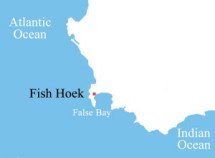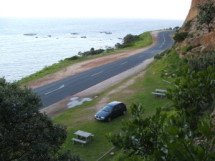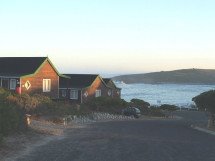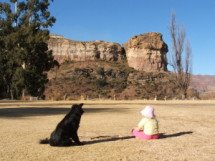 Noordhoek Beach - towards the south.
Noordhoek Beach - towards the south. Noordhoek's ideal position on the Cape Peninsula provides a great opportunity for dxing mediumwave radio stations from across the Atlantic.
After the early evening reception from Africa and the Middle East, many stations from Brazil usually make it through to this location from late evening until our local sunrise with astonishing and consistent near "local" quality peaks.
Reception from the more distant North American continent can also be quite productive during our mid summer season, as was the case during another interesting annual dxpedition to Noordhoek from the 11th - 15th January 2011.
 Noordhoek Beach - towards the north.
Noordhoek Beach - towards the north.ECUADOR
The highlight of the dxpedition was the reception of HD210A, Guayaquil, Ecuador on 1510 khz with 500 watts. The time signal station was heard over a distance of 10 626 km / 6 602 miles - a new ULR country and the most distant 500 watt station that I've been fortunate to receive via the Sony SRF M37V.
The station was last received more than 25 years ago on June 3rd, 1985 via the FRG7 receiver and a 30 metre random antenna at Sandbaai.
My thanks and appreciation to Bruce Portzer for kindly providing the information and URL links and to Chuck Hutton for listening to the audio clip and providing some sound advice!
BRAZIL
Another highlight included the reception of Super Radio Tupi, Cachoeiro de Itapemirim on 1590 kHz with 250 watts - a personal first.
TRINIDAD
It was also a pleasant surprise to hear Inspirational Radio 730 AM, Port of Spain, Trinidad on 730 khz for the first time - a personal first and another new ULR country.
U.S.A.
The reception of KOA Denver CO on 850 khz over 14 981 km / 9 308 miles represents a new ULR logging and the most distant 50 kw station that I've been fortunate to identify via the Sony SRF-M37V.
KSL Salt Lake City UT on 1160 kHz would have been eligible as the most distant station heard with the Sony Ultralight but could not be identified during a brief tentative appearance.
 No fires are allowed on the beach - but dxing with an ultralight radio is permitted!
No fires are allowed on the beach - but dxing with an ultralight radio is permitted!The Loggings : Freq (kHz) and Time (UTC)
531 2130 ALGERIA Alger Chaîne 1 Ain-El-Beida in AA 1 sec delay // 549 kHz 14/01
549 2130 ALGERIA Alger Chaîne 1 Les Trembles in AA 14/01
621 0400 CANARY ISLANDS RNE Tenerife in SS w tail end of 60's music programme, time "pips" and station identification - a common guest here with a huge "local quality" signal 15/01 audio clip
660 0320 U.S.A. WFAN New York NY w Nets vs Phoenix Suns basketball commentary by Chris Carino , id " Sports Radio 66 WFAN " and ads 13/01
670 0350 U.S.A. WSCR Chicago IL w Minissota Vikings game highlights, a reference to sister station WBBM News Radio 7-80 and talkback 11/01
680 0259 U.S.A. WRKO Boston MA w promo by Pat Whitley : " ... Hi. This is Pat Whitley. You can join me for the 'Pat Whitley Restaurant Programme', Sunday at 10:00 am until 1:00 pm that makes you the restaurant critic. Sunday at 10:00 o'clock on WRKO ... " followed by WRKO news at 0400 UTC 11/01
680 0405 U.S.A. WCBM Baltimore MD w id "Talk Radio 6-80 WCBM" 13/01 * new ULR log
700 0336 U.S.A. WLW Cincinatti OH w ad : " ... Call now. You'll get free installation the very next day - three ways to save and free next-day installation from Time Warner Cable ... call 1800 TW Cable today ... " 14/01
710 0402 U.S.A. WOR New York NY w promo by pharmacist/nutritionist Jerry Hickey of InviteHealth : "Call 800 765 73 58 now to join Jerry at this special live broadcast of InviteHealth Saturday Morning Show. Doors open at 8:30 and the show starts at 9:00. Hurry - tickets are going fast. Call 800 765 73 58 now or visit WOR 710.com/newyou for more details ... ". Most consistent station from the U.S.A. with good peaks 11-01 audio clip
720 0320 U.S.A. WGN Chicago IL w id and talkback 11/01
730 0325 TRINIDAD Inspirational Radio 710 AM Port of Spain w ann of upcoming events by female announcer w Caribbean accent - also heard during a subsequent peak with a prayer 13/01 * personal first and a new ULR country audio clip
730 0259 CANADA CKAC Montreal ON w sports commentary in FF 13/01
750 0304 U.S.A. WSB Atlanta GA w id and news report 11/01
750 0255 VENEZUELA RCR Caracas w ann in SS - a regular here - fair peak 13/01 audio clip
 The main headquarters of RCR, Caracas, Venuzuela (Photograph Wikimedia Commons).
The main headquarters of RCR, Caracas, Venuzuela (Photograph Wikimedia Commons).760 0044 U.S.A. WJR Detroit MI w ad and ann incl id : " ... and now back to Mark Levin. ' JR ' News/Talk station ... " followed by The Mark Levin Show 14/01
770 0315 U.S.A. WABC New York NY w telephonic interview by male presenter 13/01
780 0328 U.S.A. WBBM Chicago IL w id and ads 11/01
790 0307 U.S.A. WNIS Norfolk VA w Virginia Tech Hokies vs North Carolina basketball commentary 14/01 audio clip
800 0025 NETHERLANDS ANTILLES TWR Bonaire w "Through The Bible Radio" 11/01
800 0356 CANADA CKLW Windsor ON w talkback 14/01
810 0320 U.S.A. WGY Schentectady NY w talkback 13/01
820 0320 U.S.A. WBAP Fort Woth TX (presumed) w nutritional advice 13/01
820 0345 ST. KITTS Radio Paradise w gospel music - good peak 14/01
830 0305 U.S.A. WCRN Worcester MA with news and ads incl "Diamond Chevrolet" : " ... It takes a tough truck to stand up to New England weather and it's why you see more and more Chevrolet trucks on the road than ever before. At Diamond Chevrolet ... we've got a great selection of 2011 Chevy trucks ... " 13/01
830 0358 U.S.A. UNIDENTIFIED co-channel mix with WCRN 11/01
840 0304 U.S.A. WHAS Louisville KY w Fox News Radio id, WHAS "jingle" and stock market report 13/01
 A picturesque pathway through Chapmans Peak Caravan Farm.
A picturesque pathway through Chapmans Peak Caravan Farm.850 0400 U.S.A. WTAR Norfolk VA w id "News, talk, sports, financial news, consumer information, personal advice, traffic, weather. AM 8-50 WTAR, Norfolk" followed by time check for 11:00 pm and CNN Radio news read by Greg Black - very good peak 11/01 audio clip
850 0415 U.S.A. KOA Denver CO w ads including mention of telephone number with Denver area code 303 (303 759 44 ... 4) and "The First Annual Truck, Trailor and Equipment Sale at ... main road in Denver ... " received over a distance of 14 981 km / 9 308 miles * a new ULR log and the most distant 50 kw station received with the Sony SRF M37V 13/01 audio clip
860 0336 CANADA CJBC Toronto w discussion in FF 11/01
880 0339 U.S.A. WCBS New York NY w traffic update, a wx forecast by meteoroligist Bob Smerbeck followed by an airport wx condition forecast by the anchor/presenter and an id with time check as : " WCBS News time : 10:40 ... " - good peak 13/01
890 0345 U.S.A. WLS Chicago IL (presumed) w ads - 13/01
900 0210 CANADA CHML Hamilton ON w id as "Hamilton's News Talk Leader ... CHML" 13/01
930 0310 U.S.A. WBEN Buffalo NY (presumed) w sports discussion 11/01
950 0315 U.S.A. WPEN Philadelphia PA w ESPN promo : " ... BCS National Championships Game on ESPN Radio ... Join Michael McNamara ... breakdown the game at 9:00 am (Eastern) at ESPN radio ... " 13/01
990 0023 U.S.A. WNML Knoxville TN a possibility here w discussion by male presenter 14/01
 The dx location inside the caravan farm. A 100 metre BOG was directed from the car, past the Bougainvillea flowers on the left, towards the U.S.A.
The dx location inside the caravan farm. A 100 metre BOG was directed from the car, past the Bougainvillea flowers on the left, towards the U.S.A.1000 0335 U.S.A. WMVP Chicago IL w ads : " ... Visit athletico.com or call 1-877 ATLETICO. AthletiCo : physical and cccupational therapy for the Chicago Bulls ... Start your week off right and chill out at Chili's. Visit any Chicago Chili's restuarant and take advantage of these great meal deals ... " 13/01
1010 0340 U.S.A. WINS New York NY w id : " All news all the time. This is 10-10 WINS. You give us 25 minutes, we'll give you the world ". News anchor Susan Richard continued : " ... Good evening. Five degrees. We have clear skies. It is 10:40 on this Monday, January 10th. I'm Susan Richard and here is what's happening ... " 11/01
1010 0230 U.S.A. WJXL Jacksonville Beach FL (presumed) w sports commentary 13/01 * new ULR log
1020 0324 U.S.A. KDKA Pittsburgh w the Jim Bohannon Show 14/01
1040 0325 U.S.A. WHO Des Moines IA w political item by male presenter 14/01
1050 0310 U.S.A. WEVD New York NY with post sports game talkback 14/01
1060 0254 U.S.A. KYW Philadelphia PA w id and time check by female as "KYW News time. 9:54" followed by news reports 14/01
1070 0351 U.S.A. UNIDENTIFIED two stations w sports commentary and discussion 14/01
1080 0406 U.S.A. WTIC Hartford CT w sports results and wx 14/01
1090 0405 U.S.A. WBAL Baltimore MD w wx " ... temperatures will range in the mid thirties on Sunday. I'm John Patti in the WBAL News room and that's the latest Insta-Weather Plus Forecast ... " 14/01
1100 0340 U.S.A. WTAM Cleveland OH w discussion and lineup by male presenter 14/01
1110 0310 U.S.A. WBT Charlotte NC (presumed) w discussion 13/01
1120 2335 U.S.A. KMOX St. Louis MO w ads incl "The Blue Ocean Portfolios of St. Loius" index funds - also id as "News Radio 11-20 KMOX" 11/01
 The view from our caravan.
The view from our caravan.1130 0420 U.S.A. WBBR New York NY w ad for ' Gold Bond Intensive Healing Cream ' and sports commentary from the campus of Stanford HIgh School 15/01
1140 0300 U.S.A. WRVA Richmond VA w id and Virginia Tech Hokies vs North Carolina basketball commentary 14/01
1160 0325 U.S.A. KSL Salt Lake City (presumed) heard briefly with male presenter - very poor 13/01
1180 0306 U.S.A. R. Marti Marathon Key FL w SS ann 14/01
1190 0300 U.S.A. WLIB New York NY w id : "This is 11-90 WLIB and WBLS HGT New York" followed by programme introduction : " ... and now from the sanctuary of Healing From Heaven Temple : Dr Leo Stallworth on your Praise and Inspiration station 11-90 WLIB ... " 13/01
1200 0316 U.S.A. WOAI San Antonio TX w religious programme 14/01
1300 0330 U.S.A. UNIDENTIFIED w ads 14/01
1400 2320 GRENADA The Harbour Light Of The Windwards w religious programme 11/01
1500 0018 U.S.A. WFED Washington DC w ads including " ...1 866 Quicken ... " 14/01
1510 0354 U.S.A. WLAC Nashville TX (presumed) w heath nutrition programme by male presenter 14/01
1510 0345 EQUADOR HD210A Guayaquil Time Signal Station w time "pips" which were absent during the final 10 seconds of each minute to allow for regular time / station identification announcements under the noise floor. A characteristic longer 0.5 second time "pip" occured at the beginning of each minute.
The reception of the 500 watt station over a distance of 10 626 km / 6 602 miles proved to be the highlight of the dxpedition 15/01 * personal first, a new ULR country and the most distant 500 watt station received with the Sony M37V. audio clip
 The restored neighbourhood of Las Penas, located in downtown Guyaquil, Ecuador (Photograph Wikimedia Commons).
The restored neighbourhood of Las Penas, located in downtown Guyaquil, Ecuador (Photograph Wikimedia Commons).1530 0342 U.S.A. WCKY Cincinatti OH w sports commentary under VOA São Tomé e Príncipe 14/01
1530 2035 SAO TOME E PRINCIPE VOA Pinheira in EE with "African Beat" - a regular guest here with a huge "local quality" signal 14/01 audio clip
1539 2000 UNITED ARAB EMIRITES VOA Radio Aap Ki Dunyaa, Al Dhabbaya w VOA EE news and Urdu id - another regular guest with a good signal via a 50 metre cable slide antenna (see pic below) 14/01 audio clip
 The 50 metre cable slide inside the caravan farm also served as a good antenna for evening reception from Africa and the Middle East!
The 50 metre cable slide inside the caravan farm also served as a good antenna for evening reception from Africa and the Middle East!1540 0310 BAHAMAS ZNS1 Nassau w upbeat music - good peak 13/01
1560 0355 U.S.A. KGOW Houston TX (presumed) w sports discussion 14/01
1590 2220 BRAZIL Super Radio Tupi Cachoeiro de Itapemirim w id in PP (250 watts) 13/01* a new ULR log and personal first audio clip
1600 2215 U.S.A. WWRL New York NY w anns under Radio Nove de Julho, São Paulo, Brazil 13/01
1610 0342 ANGUILLA Caribbean Beacon w religious sermon - consistent good peaks 14/01
1660 2315 U.S.A. WWRU Elizabeth NJ 11/1
1700 0305 U.S.A. KVNS Brownsville TX w ad for "Ludens Wild Cherry Drops" - fair peak 13/01

BRAZIL
1590 Super Radio Tupi Cachoeiro de Itapemirim (250 watts) 5 970 km / 3 710 miles
CANARY ISLANDS
621 RNE Tenerife
EQUADOR
1510 HD210A Guayaquil (500 watts) 10 626 km / 6 602 miles
SAO TOME E PRINCIPE
1530 VOA Pinheira
TRINIDAD
730 Inspirational Radio 730 AM Port of Spain
UNITED ARAB EMIRATES
1539 VOA Radio Aap Ki Dunyaa Al Dhabbaya
U.S.A.
710 WOR New York NY
790 WNIS Norfolk VA (5 kw) 12 548 km / 7 797 miles
850 WTAR Norfolk VA.
850 KOA Denver CO 14 981 km / 9 308 miles
VENEZUELA
750 RCR 750 AM Caracas 10 220 km / 6 350 miles.
Receiver : Sony SRF-M37V
Antenna : 220 m, 100 m BOGs and 50 m random "cable slide"



































































